Cucumbers–natives of India–love warm weather. Wait until soil and air temperatures average 70°F each day before sowing or transplanting cumbers to the garden.
While warm temperatures are required for growing, cucumbers require a relatively short season–55 to 60 days from sowing to harvest. In long-season regions, you can plant successive crops. In cool or short-season regions, choose the warmest time of the year for growing cucumbers.
Related articles:
- Nine Cucumber Serving and Cooking Tips
- How to Make Cold, Tasty Cucumber Soup
- Cucumber Seed Starting Tips
- How to Harvest and Store Cucumbers
- Container Growing Cucumbers
- How to Plant and Grow Cucumbers
- Cucumber Growing Problems Troubleshooting
- Cucumber Beetle Organic Pest Control
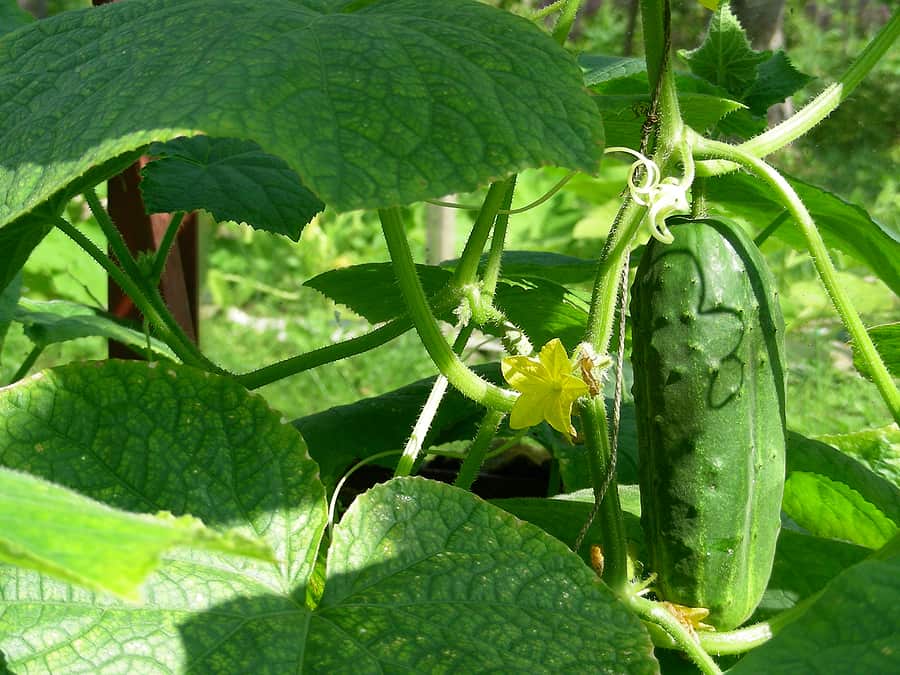
Cucumbers are weak-stemmed tender annuals that grow best in temperatures ranging from 60° to 90°F (15°-32° C). Some varieties grow like a bush, others are vining.
Quick cucumber growing tips
- Sow cucumber seed in the garden or set out transplants 3 to 4 weeks after the average last frost date in spring.
- The ideal soil temperature for growing cucumbers is 70°F (21°C).
- Sow cucumber seeds indoors as early as 6 weeks before transplanting seedlings into the garden.
- Protect cucumbers from unexpected frost or chilly nighttime temperatures early in the season. Use floating row covers or plastic tunnels to keep the chill away.
- Cucumbers require 55 to 65 frost-free days from sowing to reach harvest.
Where to plant cucumbers
Cucumbers grow best in full sun but will grow with just 5 hours of sun a day. Cucumbers are very tender vegetables; they need temperatures of 70°F (21ºC) or warmer to grow well. They grow best in growing zones 4–12. If you allow cucumber vines to sprawl on the ground you will need about 9 square feet (2.7 sq m) per plant. You can grow cucumbers vertically; place them next to a fence or a trellis. Cucumbers prefer well-drained sandy loam supplemented with compost or well-rotted manure.
- Grow cucumbers in full sun. Cucumbers can tolerate partial shade.
- Cucumbers prefer loose, well-drained soil rich in organic matter. Prepare planting beds in advance of planting by adding 2 to 3 inches (5-7cm) of aged compost, commercial organic planting mix, and aged manure to beds. Turn the soil to 12 inches (30cm) deep
- Place black plastic sheeting over the planting bed in spring to warm the soil in advance of planting.
- Cucumbers prefer a soil pH of 5.5 to 6.8. Cucumbers can tolerate alkaline soil to a pH of 7.6.
- Set trellises or supports in place to grow cucumbers up or mound the soil to create a small hill off which cucumber vines can run. Use a trellis 4 to 6 feet (1.2-1.8m) tall. Create a mound at least 16 inches (40cm) across and several inches high; space mounds 4 to 6 feet (1.2-1.8m) apart.
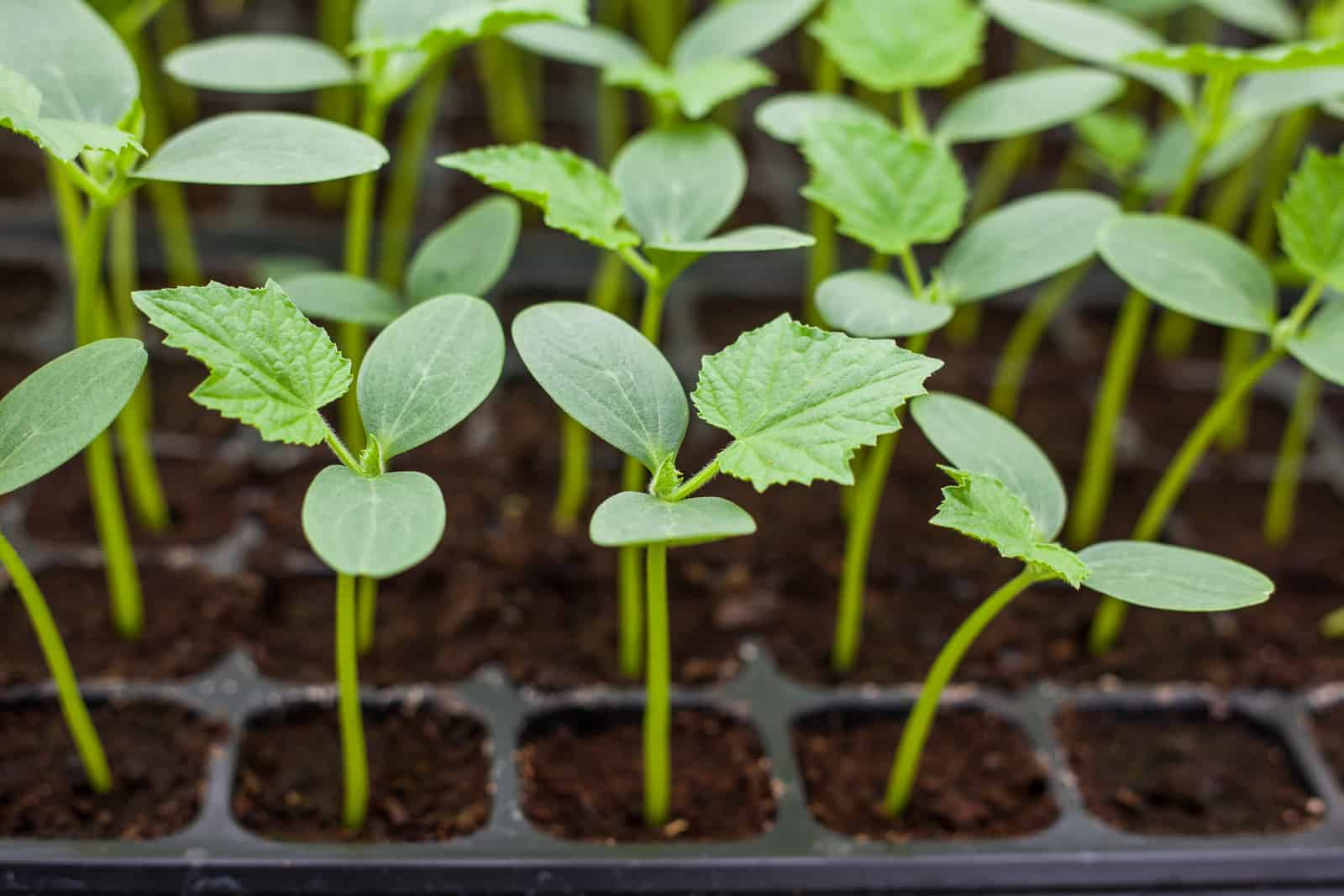
Sowing cucumber seeds
You can direct sow cucumber seed in spring after all danger of frost has passed and the soil has warmed to 70°F (21°C). The seeds will not germinate at a soil temperature below 50°F (10°C). Sow seed ¾–1 inch (1.9–3.8 cm) deep, thinned to 36 inches (90 cm) apart. Cucumbers require 55–65 frost-free days to mature.
To get a head start on the season, sow cucumbers in peat pots 3–5 weeks before planting out. Transplant cucumbers out into the garden after the soil has warmed and the weather settled. For successive crops, plant cucumbers every 2 weeks until midsummer.
Cucumber seeds will germinate in as little as three days when the soil temperature is 80° to 90°F. Sow cucumber seeds indoors about three weeks before setting seedlings into the garden. Start cucumbers indoors in individual pots so that the roots are not disturbed at transplanting. Set out cucumber starts when the garden soil temperature is 70°F or greater. You can speed garden soil warming by covering the planting area with black plastic mulch or by using mounds or raised rows to grow cucumbers.
- Sow cucumber seeds 1 inch (2.5cm) deep.
- Sow seeds at the base of the vertical support or on a mound at 6 to 8-inch (15-20cm) intervals.
- When seedlings are 3 to 4 inches (7-10cm) tall, thin to the strongest plant spaced 12 to 18 inches (30-45cm) apart for vining cucumbers on vertical supports and 24 to 36 (61-91cm) inches apart for bush varieties.
- Cut weak seedlings off at the soil level with scissors to avoid disturbing the roots of the remaining plants.
Sow seed or set out cucumber transplants after all danger of frost has passed and the soil has warmed to 60°F (16°C). Frost can stress cucumbers. If there is a danger of frost once cucumbers are in the garden, protect plants with floating row covers.
Spacing cucumbers
Plant cucumbers in full sun and set bush cucumbers 18 to 24 inches apart and vining varieties at least 24 to 36 inches apart in rows 3 feet apart. Cucumbers like well-drained roots so planting on mounds is a good idea. Set three plants on mounds 3 feet across; space mounds 6 feet apart. Set trellises or pole supports in place before you plant seedlings. To prevent diseases, air circulation around plants is important.
Sow seeds or set out seedlings in raised hills or in rows after all danger of frost has passed in spring and the soil has warmed to at least 60°. Successive crops can follow 4 weeks later. Plant one side of the trellis early and the other side later.
- Set a trellis, tripod, or cage in place at planting time if you are growing vining varieties. A 12 to 18-inch (30-45cm) diameter wire cage is ideal for growing vining cucumbers. You can make a cage from a 4 to 5-foot (1.2-1.5m) section of wire fencing or construction mesh.
- To grow an early crop, you can start cucumbers indoors 2 to 3 weeks before the last frost in spring then transplant seedlings to the garden 2 to 3 weeks after the last frost.
Growing cucumbers in containers
Cucumbers will grow in containers: choose a container at least 8 inches (20 cm) wide and 12 inches (30 cm) deep. Use a trellis or support the vine to increase yields.
Many dwarf or mini-cucumber varieties will grow in a pot as small as 6 inches (15cm) wide and deep, larger is better. Check the description of the cucumber and its space requirements. ‘Potluck’ is a small growing variety. Larger cucumbers for containers include ‘Patio Pik’ and ‘Bush Whopper.’ Use a 12- to 18-inch (30-45cm) trellis, stake, or other support to increase the yield of container-grown cucumbers.
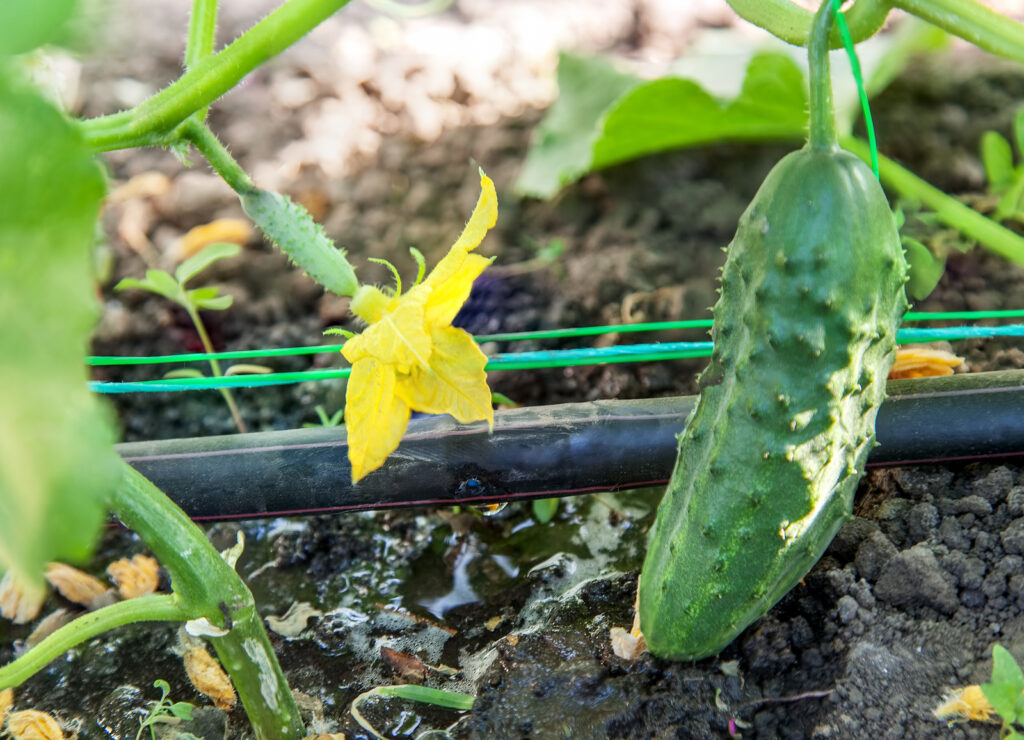
Watering cucumbers
Cucumbers require moderate water before flowering. Heavy watering from flowering to harvest will result in a larger crop. Avoid overhead watering.
Cucumbers are 96 percent water. For best growth, they require uninterrupted moisture from sprouting to harvest. Water seedlings well, and keep the soil moist throughout the season especially when flowering and fruiting. Bitter and misshapen fruit is the result of water stress. To stem moisture evaporation, cover the soil with black plastic or thick compost mulch after planting.
Keep cucumbers evenly moist. Mulch to conserve soil moisture once the soil has warmed.
- Keep the soil evenly moist with regular watering. Do not let the soil dry out. Cucumbers are about 95 percent water and require regular water for fast, even growth.
- Set a soaker hose or drip irrigation at the base of plants. Give cucumbers at least 1 inch of water each week during the summer.
- Always water at the base of plants. Moisture on cucumber leaves can result in fungal diseases such as powdery and downy mildew.
- Leaves may wilt in the afternoon in hot weather; that is because plants are taking up water faster than roots can supply.
- If plants are wilted in the morning, the soil is too try and needs immediate water.
- Mulch around plants to slow soil moisture evaporation and to avoid soil compaction caused by heavy watering.
- Too little water or inconsistent watering can cause cucumbers to become oddly shaped or bitter tasting.
- An easy way to measure soil moisture is to stick your index finger in the soil; if your finger comes away dry, it’s time to water.
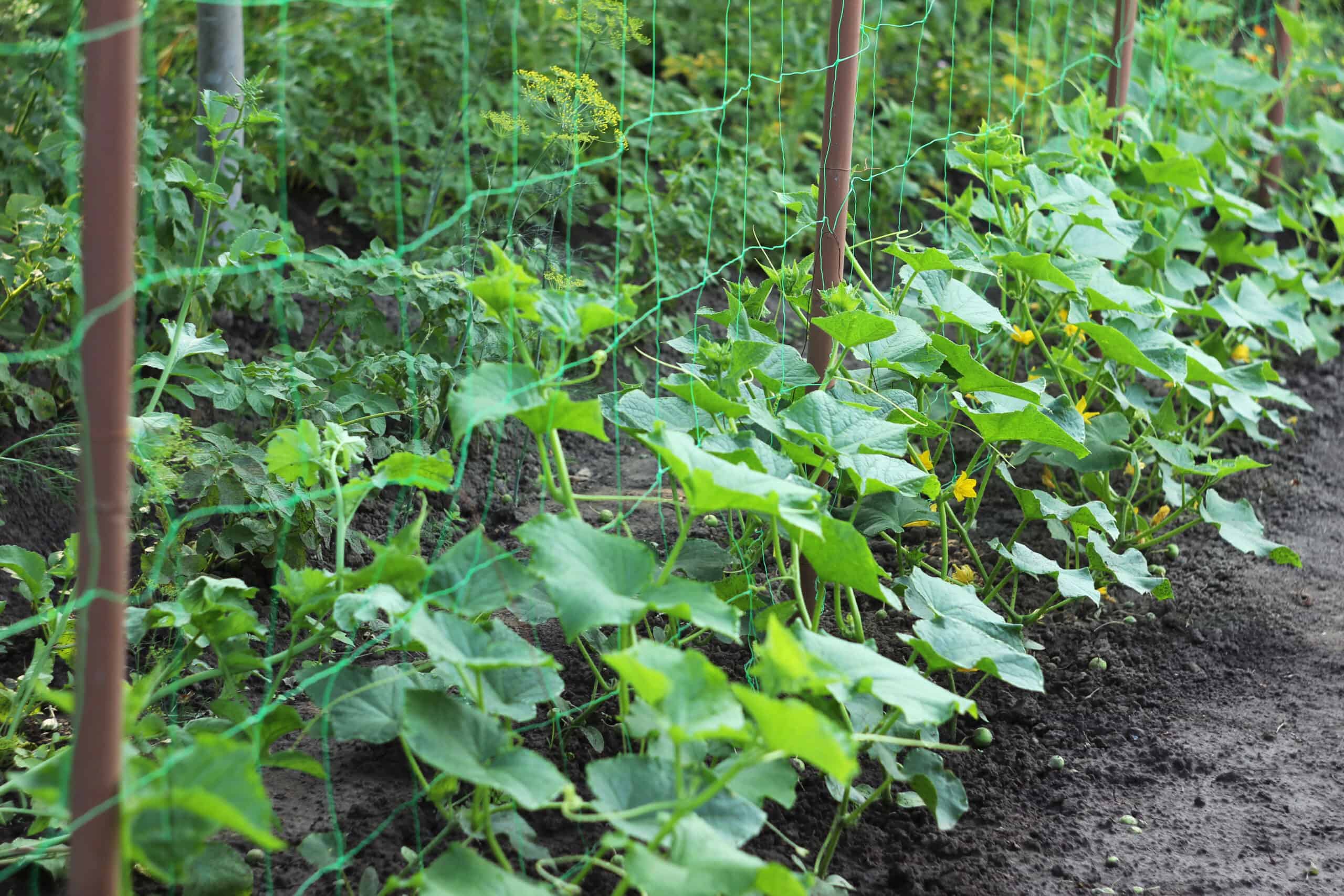
Feeding cucumbers
Cucumbers are heavy feeders. They prefer ample amounts of phosphorus and potassium and a moderate amount of nitrogen. Add compost and phosphorus to the soil before planting.
Spray cucumbers with fish emulsion or compost tea 1–2 times per month during the growing season. Fertilize with blood meal during the period before blooming.
Add plenty of aged compost or manure to the planting bed in advance of sowing. Before you plant, place aged compost or manure at the bottom of each planting hole and throw in a buffer inch or two of native soil. (An all-purpose organic fertilizer, 10-30-10 can be used–follow the label directions.) This will get plants off to a strong start. Apply compost tea or manure tea at transplanting or two weeks after seedlings emerge. Feed again with compost tea in three weeks or when the first flowers appear. When the first fruit sets, water each plant with compost tea or side-dress each plant with a shovel full of compost. If leaves are pale, give plants a dose of fish emulsion. But be careful not to give squashes too much nitrogen; nitrogen will increase leafy growth but cut fruit yield.
- Add aged compost or commercial organic planting mix to planting beds before planting. Compost has all the nutrients cucumbers need for fast growth.
- Side-dress cucumbers with compost tea or a dilute solution of fish or kelp emulsion or a liquid organic fertilizer every 10 to 14 days during the season.
- Feed cucumbers with low nitrogen, high phosphorus, and potassium formula. Be careful to follow label directions; over-fertilizing can stunt or harm plants.
- Side-dress cucumbers at midseason with aged compost to renew soil nutrients.
- Keep planting beds free of weeds; weeds compete for soil nutrients and water. Cultivate shallowly to avoid disturbing roots.
Caring for cucumbers
- Mulching. Once the soil has reached 70°F (21°C), reduce soil moisture evaporation by mulching plants with an organic mulch or black plastic. Mulch will also reduce weeds which compete for soil moisture and nutrients. Mulch around cucumber plants with straw or chopped leaves. Mulch will help conserve soil moisture, and keep vines, and fruits clean. Slugs and snails find it difficult to move across straw or pine straw mulch.
- Give cucumbers plenty of water; do not let the soil go dry especially while they are flowering and fruiting. Water stress during the early stages of growth will cause bitter-tasting compounds to concentrate in the fruit. Water cucumbers deeply once or twice a week or place plants on a drip so that the soil stays moist but not wet. Use your finger to measure soil moisture; the soil should not be dry deeper than 3 inches below the surface.
- Protect cucumbers from high temperatures. Temperatures consistently in the mid-90s or warmer can stress cucumbers. Provide filtered afternoon shade to help cool the garden; plant cucumbers to the south of tall crops such as corn or sunchokes or place a frame and shade cloth with a 40 to 50 percent block of sunlight over cucumbers.
- Protect cucumbers from cool temperatures. Cucumbers do not like chilly weather or chilly soil. They will die back with even a touch of frost. When night temperatures fall below 65°F protect cucumbers with floating row covers.
Growing cucumbers that are not bitter tasting
Cucumber plants that are stressed during the growing season may produce fruit that is bitter-flavored. Commonly a lack of water or temperatures too cold or too hot cause cucumbers to bear bitter-tasting fruit.
But some cucumbers may have a slightly bitter flavor by nature. Cucumbers contain organic compounds called cucurbitacins that can cause fruit to taste bitter. Low levels of cucurbitacins are not detectable, but high levels make fruits taste bitter. Cucurbitacin levels may increase with environmental stress during the growing season.
To avoid bitter-flavored cucumbers, plant varieties that have very low levels of cucurbitacins or give cucumbers optimal growing conditions.
Plant cucumbers in a sunny spot in soil rich in organic matter and well-drained. Raised beds or mounds are ideal for growing cucumbers; the soil will warm early in the season and stay warm. Work several inches of aged compost and aged manure into the planting beds ahead of sowing or transplanting. During the season, side-dress plants with aged compost. Compost is nutrient-rich and moisture retentive.
Give cucumbers plenty of room to grow; trellised or caged cumbers should be spaced 8 to 12 inches (20-30 cm) apart. Space hills for growing cucumbers at least 3 feet (91 cm) apart.
Choose cucumber varieties that are not bitter-flavored. The level of cucurbitacins in cucumbers varies by variety but also from plant to plant and even fruit to fruit on the same plant. (An enzyme called elaterase also present in cucumbers can reduce the number of cucurbitacins but the amount of elaterase can vary from season to season and plant to plant as well.)
Cucumber varieties with low levels of cucurbitacins include ‘Jazzer’, ‘Holland’, ‘Lemon’, ‘Aria’, and ‘Marketmore 97’. Keep a garden journal and note varieties you have grown that was not bitter tasting.
Bitterness concentrates on the stem end and skin of the cucumber. Peel the fruit and cut off the stem end by an inch or two to reduce bitterness at serving time. Rinse your peeling knife after each slice so that you do not spread the bitter taste.
Pruning cucumbers
Cucumbers easily grow on trellises, cages, fences, or poles. A 4-foot-high wire cage is about the right size. When vines reach the top of the cage, trellis, or fence, pinch out the fuzzy growing tip. This will allow plants to spread laterally. Fruits that grow curved on the ground will grow straight when hanging from supports.
Cucumber companion plants
Cucumbers grow well with bush beans, broccoli, cabbage family, corn, dill, eggplant, kale, lettuce, melon, nasturtium, peas, pumpkins, radish, squash, sunflower, and tomatoes. Avoid plating cucumbers with potatoes and herbs.
- Grow cucumbers with beans, corn, peas, pumpkins, and squash. Do not grow cucumbers with potatoes and herbs.
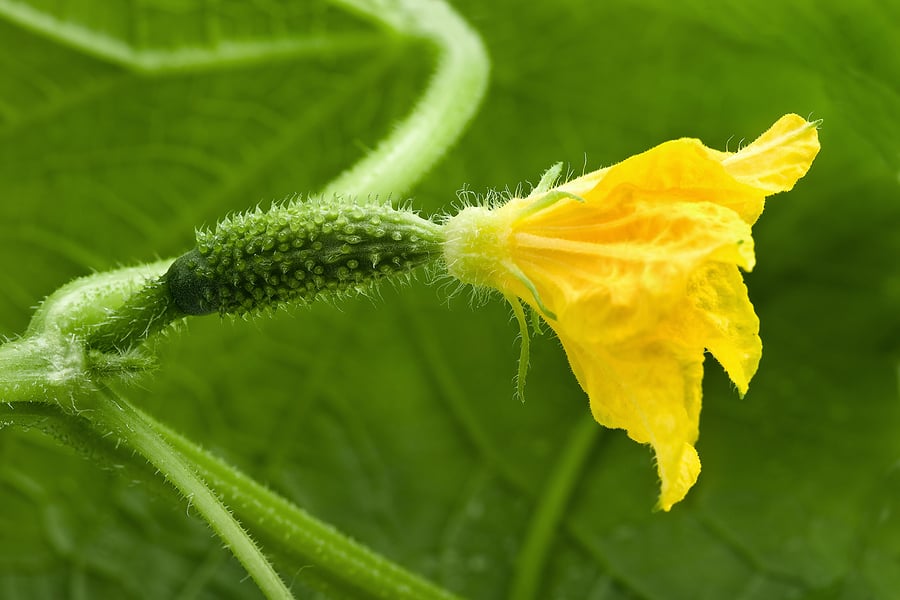
Monoecious and gynoecious cucumbers
Most cucumbers are either monoecious or gynoecious. Monoecious plants have both male and female flowers on the same plant; the first flowers that appear are male or non-fruiting; fruiting female flowers appear 7 to 10 days after at the end of shoots. Gynecious cucumbers have only female flowers. They require a male flower on a nearby plant for pollination. (Packets of gynoecious cucumber seeds commonly contain pollinator-plant seeds; these seeds will be color coated for identification.) Cucumbers are pollinated by visiting insects or birds. (Most cucumber varieties are monoecious.)
- Most cucumbers are monoecious, meaning plants produce both female and male flowers. Female flowers are commonly pollinated by insects after visiting male flowers.
- Hybrid cucumber varieties are gynoecious. Gynoecious cucumbers produce only female flowers. These plants must be set near a monoecious plant for pollination or must be pollinated by hand. Gynoecious cultivars include ‘Conquest,’ ‘Early Pride,’ and ‘Bush Baby.’
Cucumber flowering and fruit formation
- Cucumbers have separate male and female flowers. The first flowers to appear are male flowers that will not produce fruit.
- Female flowers appear a week or so after male flowers. A female flower will have a cucumber-shaped swelling at the stem end of the flower; this is the unpollinated fruit.
- Female flowers are pollinated when bees or other insects carry pollen from the male flower to the female flower. Some male flowers may die and drop before female flowers appear. Be patient or sow seeds every couple of weeks so that there are male and female flowers in the garden at the same time.
- To attract bees to flowers, spritz plants with dilute sugar water.
- If plants are in a greenhouse or hoop house where pollinating insects cannot come or if pollination is slow or does not occur, use a soft-bristled brush to hand pollinate flowers; dust the inside of a male flower then carefully dust the inside of a female flower. A female flower will have an immature fruit on its stem, a male won’t.
- Gynoecious, hybrid cucumbers require pollinator plants; monoecious plants with female flowers.
- Cucumber fruits hanging from a trellis or vertical support will grow straight under the force of gravity.
- Cucumbers growing on the ground should be set on a tile or piece of wood so that the fruit does not have direct contact with the soil; this will allow cucumbers to mature with less exposure to disease and insects.
- Cool-weather, rain, and insecticides can delay or harm pollination.
Cucumber pests
Aphids, cucumber beetles, and other beetles and insects can attack cucumbers. Floating row covers will protect young plants before they bloom. After blooming, pinch out infested vegetation or hose off aphids or cucumber beetles, and hand-pick cutworms, slugs, snails, and squash bugs.
Squash beetles and striped cucumber beetles can be regular visitors–feeding at night. (Cucumber beetles are attracted to the bitter compound in the skin of many cucumber varieties.) Handpick these pests in the early morning or plant varieties that don’t have the bitter compound–‘Holland’, ‘Aria’, and ‘Lemon’ are good choices.
Turn away cucumber beetles when plants are young. Cucumber beetles eat plants and spread disease. Set floating row covers over seeded rows and seedlings to exclude cucumber beetles early. Lift row covers when plants begin to flower.
- Cucumbers can be attacked by aphids, cucumber beetles, squash bugs, and slugs.
- Control aphids by hosing them off with a blast of water or pinching out infested vegetation.
- Cucumber beetles chew holes in leaves and can spread cucumber bacterial wilt when feeding on plant tissue. Hand-pick them off the vines and destroy them.
- Squash bugs suck plant sap causing leaves to wilt. Squash bugs will also attack seedlings. Dust plants with diatomaceous earth around the base of plants.
- Slugs can scrape ragged holes in leaves. Spread diatomaceous earth around the base of plants.
Cucumber diseases
Several plant viruses and fungi can plague cucumbers. Plant disease-resistant varieties, and remove and destroy infected plants. Do not grow cucumbers or their relatives, such as squash and melons, in the same spot more often than once every 3 years.
Prevent fungal disease from getting a grip on the garden. Avoid overhead irrigation; use a soaker hose or drip irrigation. Spray vines early in the day with compost tea to protect plants from fungal spores. Keep the garden free of weeds which can harbor pests and diseases.
Cucumbers can also be plagued by wilts and powdery mildew. Plant disease-resistant varieties: look for letter codes indicating diseases resistant, leaf spot (LS), anthracnose (A), wilt (BW), mosaic (M), scab (S), and mildew (DM).
- Cucumber plants are susceptible to scab, mosaic, and mildew.
- Keep the garden clean of debris and weeds that can harbor pests and diseases.
- Remove diseased plants immediately; put them in a paper bag and throw them in the trash to avoid the spread of disease.
- Plant disease-resistant varieties. Look for the following coding to indicate disease resistance: leaf spot (LS), anthracnose (A), bacterial wilt (BW), mosaic (M), scab (S), and downy mildew (DM).
- Bacterial wilt is spread by cucumber beetles; plants suddenly wilt and die just as they begin to produce. Control beetles as soon as they appear.
- Powdery mildew and downy mildew, fungal diseases, will cause cucumber leaves to turn grayish-white late in the season. Slow the spread of fungal diseases by spraying plants with horticultural oil or neem oil.
- To help prevent fungal diseases, plant resistant varieties, and space plants further apart to increase air circulation.
More on cucumber problems: Cucumber Growing Problems: Troubleshooting.
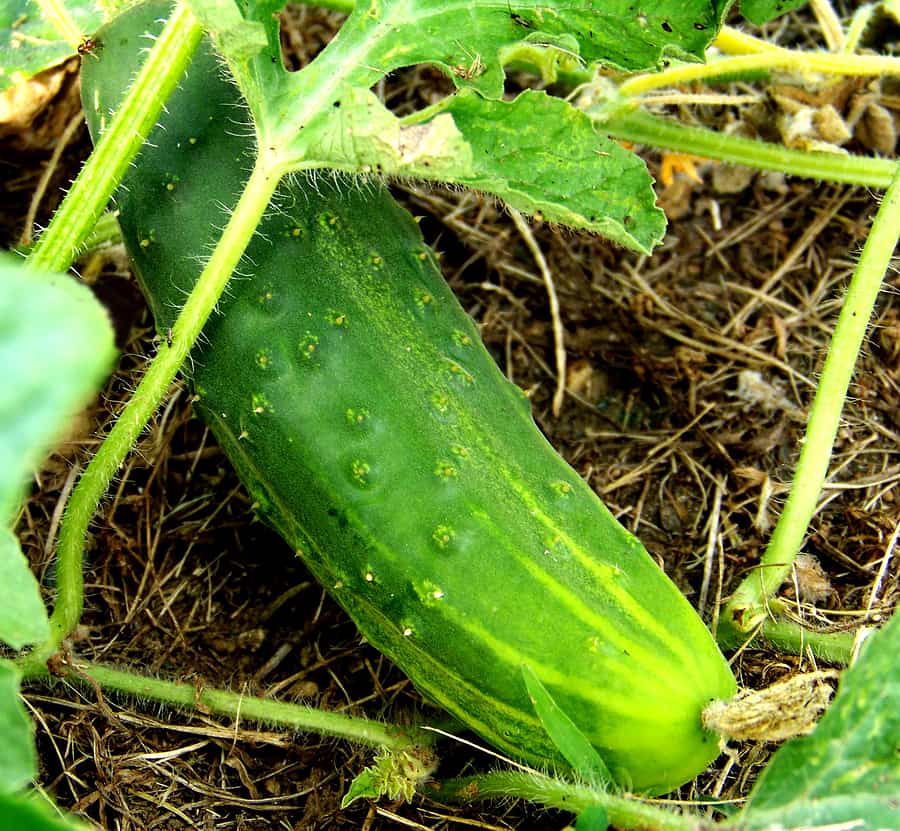
Harvesting cucumbers
Cucumbers are ready for harvest usually from midsummer onwards. Harvest cucumbers 3 to 4 times per week as fruit matures; this allows the setting of new flowers and fruit. Harvest when the fruit is elongated and the seeds are still succulent.
Harvest cucumbers when they are green, firm, and moderate in size. Harvest slicing cucumbers when 6-10 inches long, pickling (sweet pr baby dills when 1-6 inches long, regular dills when 3-4 inches long. The best rule is to pick cucumbers as soon as they reach usable size. Cucumbers left on the vine too long will become seedy and bitter. Cucumbers that are dull, puffy, and yellowing are past their prime. A prompt harvest will allow plants to set new fruit. Fruit left to mature on the plant will completely stop the set of new fruit.
- Cucumbers will be ready for harvest 55 to 65 days from sowing.
- Harvest cucumbers as soon as they reach mature size; cucumbers left on the vine past maturity will suppress the production of new flowers and fruit.
- Check and harvest cucumbers daily to stay ahead of the harvest.
- Slicing cucumbers are best picked when they are 6 to 8 inches (15-20cm) long.
- Clips cucumbers off of plants with a garden clipper, scissors, or knife. Pulling cucumbers off plants can damage plants.
- A fruit that turns yellow at the blossom end opposite the stem is overripe and will be seedy.
- Pickling cucumbers–sweet or dill–are best picked when 1 to 6 inches (2.5-15cm) long. Pick pickling cucumbers every two days.
- Regular dills are best picked when 3 to 4 inches (7-10cm) long.
- Burpless cucumbers should be picked at about 10 inches long.
- Hothouse-grown English or Armenian cucumbers are best picked when 12 to 15 inches (30-38cm) long.
- Cucumbers left on the vine too long will have tough skins and will lose flavor.
More harvest tips: How to Harvest and Store Cucumbers.
Pick cucumbers at their optimum size and pick them frequently. Cucumbers should be ready for picking 50 to 70 days after planting. When the cucumber drops its flower at the blossom end of the fruit, the fruit is ready for harvest. Cucumbers are less tasty when they grow too big.
Know the mature size of the cucumbers you are growing: about 6 to 8 inches (15-20 cm) for American slicers, 4 to 6 inches (10-15 cm) for Middle Eastern types, 3 to 5 (7-13 cm) inches for pickling types; 8 to 12 inches (20-30 cm) for Asian varieties.
Storing and preserving cucumbers
- Pickling and slicing cucumbers will keep in the refrigerator for 7 to 10 days.
- Hothouse cucumbers will keep in the refrigerator for 1 to 2 days. Be sure the temperature is not too low or cucumbers will freeze and turn soft.
- Wrap refrigerated cucumbers in plastic or store them in a zipper bag to keep them crisp.
- Pickled cucumbers will keep for up to 1 year.
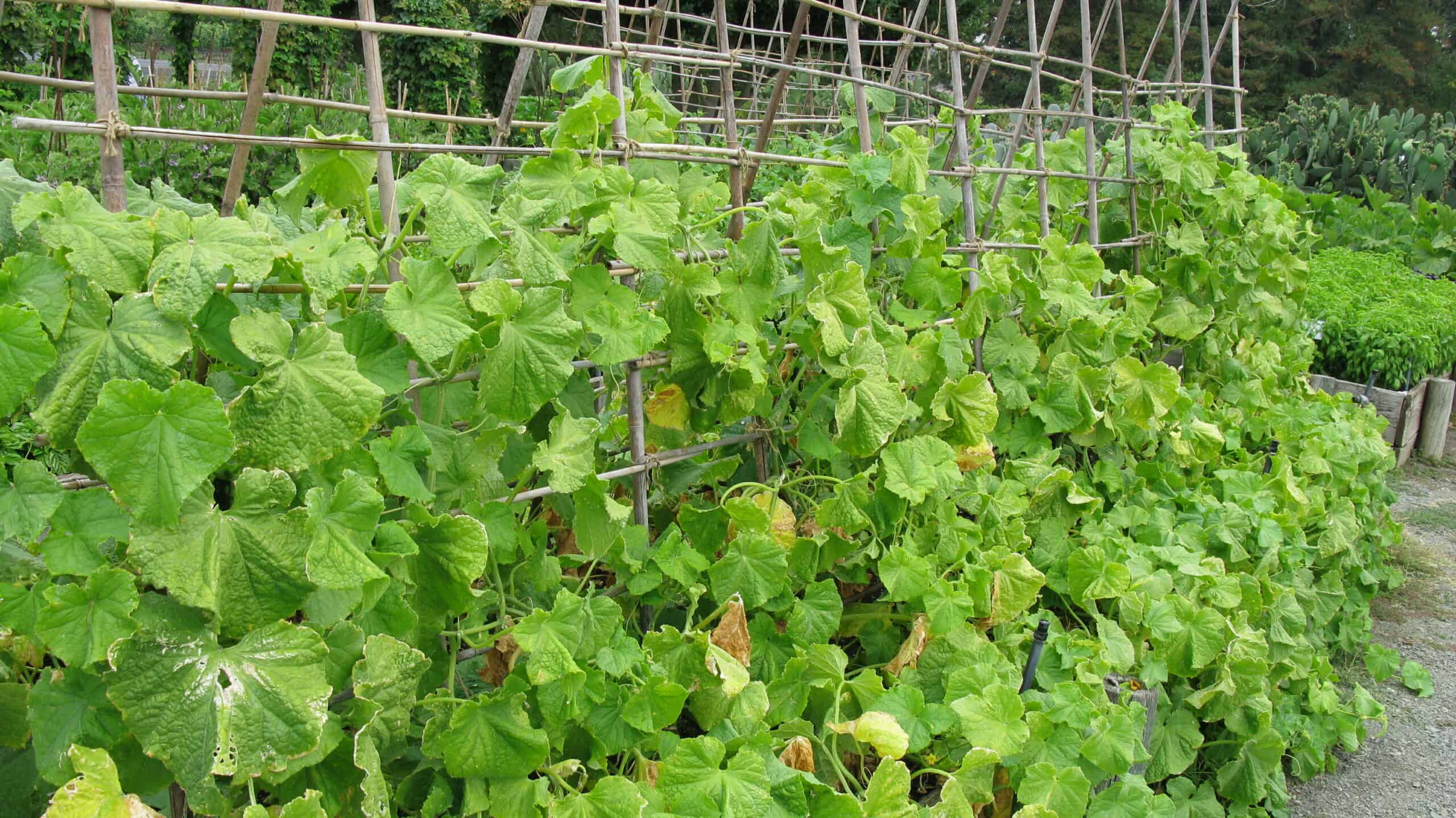
Types of cucumbers
There are many types and varieties of cucumbers. Here are the differences:
- Bush cucumbers can grow 24 to 36 inches (61-91cm) tall and wide forming a compact plant. Bush cucumbers are well-suited for container growing or small gardens. Plant bush varieties every two weeks for a continuous harvest.
- Vine cucumbers can grow to 6 feet (1.8m) high or more and 2 to 3 feet (.6-.9m) wide. Vining cultivars require more space but produce more fruit. Grow vining cucumbers on a fence, trellis, or tripods when possible to keep fruit off the ground.
- Pickling cucumbers have thin, pale green skin, bear fruit early, and concentrate fruiting in a 10-day period. Pickle cucumbers a few hours after harvesting for crisp pickles.
- Slicing cucumbers, for fresh eating, commonly are green-skinned and set fruit for 4 to 6 weeks. Slicing cucumbers include “burpless’ cultivars which are mild-flavored and easy to digest.
- European, English, or greenhouse cucumbers are seedless cultivars developed for greenhouse growing.
- Lemon cucumbers are yellow oval-to-round heirloom cucumbers. Lemon cucumbers are ideal for a single serving. Harvest lemon cucumbers just as they turn yellow; do not wait too long or they will be seedy.
- Asian cucumbers are thin, heavily ribbed cultivars; the fruit grows from 12- to 24-inches (30-61cm) long.
- Gherkin is a term used for any pickling cucumber; however, a true gherkin is not a cucumber but the fruit of a different species, Cucumis anguria.
- Cornichons is the generic French term for any small cucumber.
Cucumber yield
- Grow 2 to 3 cucumber plants per household member for fresh eating.
- Grow 3 to 4 plants per quart for pickling.
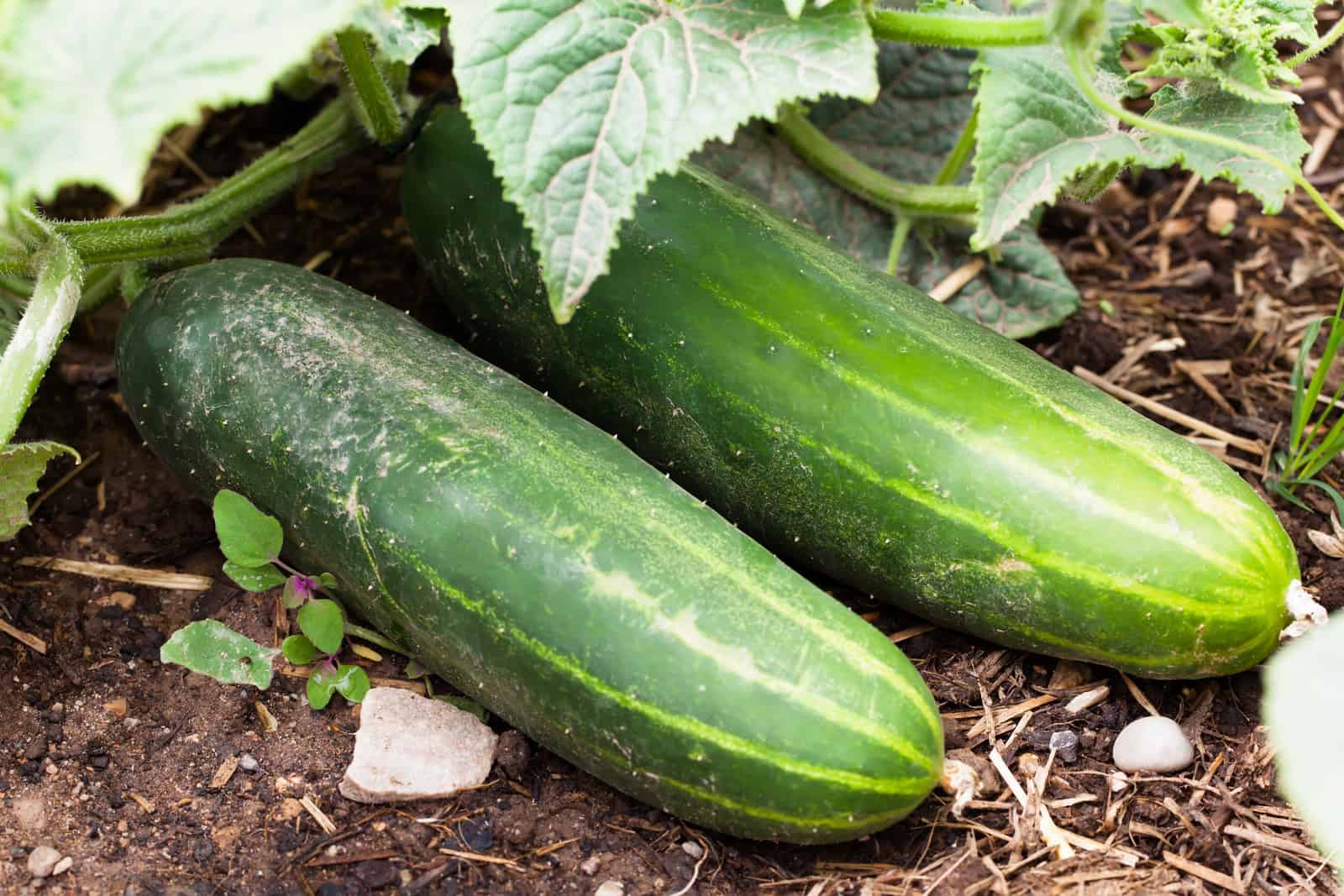
Cucumber varieties to grow
Cucumbers are divided into slicing cucumbers for fresh eating and pickling cucumbers. There are dozens of varieties to choose from. In the list below “gyn” denotes gynoecious which produces only female flowers and must be grown near a monoecious plant; others are monoecious, which produce both male and female flowers.
Choose from these slicing cucumbers: ‘Marketmore’, ‘General Lee’, ‘Bush Champion’, ‘Salad Bush’, and ‘Sweet Success’. Choose from these picklers: ‘Pickalot’, ‘Pioneer’, ‘Little Leaf’, and ‘Northern Pickling’. Other cucumber types include: ‘Suyo Long” an Asian slicing; ‘Lemon’ which is lemon-shaped, and ‘Armenian’. For containers, choose ‘Pot Luck’, ‘Bush Champion’, ‘Spacemaster’, ‘Patio Pik’, and ‘Salad Bush’.
- Slicing: Ashley (66 days); Comet II (gyn-60 days); Dasher II (55 days); General Lee (gyn-55 days); Jazzer (48 days); Marketmore (76 days); Poinsett (65 days); Revenue (gyn-48 days); Slice King (49 days); Spacemaster (60 days); Speedway (gyn-56 days); Supersett (53 days); Sweet Slice (62 days); Tasty Green (55 days); Ultra-Slice Early (56 days).
- Pickling: Baby Bush (51 days); Calypso (gyn-56 days); Conquest (gyn-50 days); Cross Country (51 days); Edmondson (70 days); Green Spear (gyn-55 days); Pik Rite (gyn-63 days); Salty (53 days); Spear It (gyn-52 days); Sumter (56 days).
- Burpless: Comet II (gyn-60 days); Green Knight (60 days); Jazzer (48 days); Perfection (60 days); Sweet Slice (62 days); Tasty Green (55 days).
- Greenhouse: Aidas (gyn-65 days); Carmen (gyn-65 days); English Telegraph (65 days).
- Container varieties: Patio Pic (50 days); Potluck (50 days); Spacemaster (60 days); Bush Whopper.
- Others: Lemon (64 days); Long White (65 days); White Wonder (60 days).
Chose the right variety
Choose disease-resistant varieties and choose the variety right for your needs: slicing cucumbers are for salads and sandwiches; pickling cucumbers are for storing; and European cucumbers are for fresh eating–they are tenderly skinned, have no seeds, and mild flavored. Double check the cucumber’s pollination requirement: gynoecious cucumber varieties produce female flowers only and require a separate male pollinator (these are usually disease resistant); parthenocarpic varieties produce only female flowers but do not require a pollinator–these are a good choice for greenhouse growing.
Cucumber varieties by type
Cucumbers for the home garden can be divided into four popular cucumber types: (1) slicing, (2) pickling, (3) burpless, and (4) space savers for small gardens and containers.
Here are 20 easy-to-grow cucumber varieties to grow in your garden.
Abbreviations:
- AAS=All America Selection resists most diseases.
- ALS=Angular leaf spot.
- AN=Anthracnose.
- CMV=Cucumber mosaic virus.
- DM=Downy mildew.
- M=Mosaic virus.
- PM=Powdery mildew.
- S=Scab.
Slicing cucumbers varieties:
• Dasher II. 55-60 days. CMV, DM, PM, S. Cool, crisp flesh, and great flavor. Slim dark-green fruit, 8½ inches long and 2¼ inches across. Standard slicing fruit. Compact heavy-yielding plants. Hybrid.
• Diva. 58 days.S, PM, CMV. Seedless, thin-skinned, distinctly crisp, sweet, and bitter-free. All-America selection in 2002. Harvest at 5 to 7 inches. Parthenocarpic—it needs no pollinator to flower and fruit.
• Greensleeves. 53 days. Excellent for salads and slicing. Dark-green, cylindrical fruit to 8½ inches long; uniform size, slightly tapered; small seed cavity. Good yield in the home garden on vigorous vines. Responds well to tough conditions. Early maturing. Gyonecious, mostly female flowers.
• Marketmore 76. 58 days. ALS, AN, CMV, DM, S. Standard slicing fruit, uniform size, long and slender. Dark green fruit, 8 to 9 inches long; white-spined; has a uniform dark green color gene which reduces the number of yellow bellies at harvest time. Very good in home gardens. Open-pollinated.
• Marketmore 80. 61-68 days. DM, ALS, AN, CMV, DM, PM, S. Improved Marketmore 76. Bitter-free even when large; for salads and slicing. Blocky, firm-skinned, dark-green fruits 6 to 8 inches long, 2½ in diameter. Good cool season main crop; plant in the fall in warm-winter gardens. Open-pollinated.
• Raider. 50-52 days. ALS, CMV, S. Excellent flavor; for salads and slicing. Straight, cylindrical, smooth, glossy, deep-green skin; uniform size. Vigorous, robust vines. Plant early does well in Canada and cool northern gardens. Gyonecious, mostly female flowers Hybrid.
• Slice Master Hybrid. 48-55 days. ALS, AN, DM, M, PM, S. Tasty slicing fruit. Dark-green fruit to 8½ inches. Early variety. Good yield. Mostly female flowers. Hybrid.
• Straight Eight. 58 days. AAS. Great taste; excellent slicing’ is also for pickling. Uniform, straight, deep-green fruit, 6 to 9 inches long 2½ inches in diameter, rounded at ends, white spined; small seed cavity. Small, vigorous, high-yield vine for the home garden; extended harvest. Heirloom. Open-pollinated.
• Sweet Success. 55-58 days. AAS, AN, ALS, CMV, DM. PM. S. Sweet, crisp, flavor. No bitterness. Thin skin does not require peeling. Smooth, straight, medium-green fruit 12 to 14 inches long; white spined; seedless. Vigorous, high-yield vine sets fruit without pollination. Best grown on stake or trellis, suitable for greenhouse cultivation. Hybrid.
Burpless cucumber varieties:
• Burpless Hybrid. 62 days. CMV, DM, PM, S. Crisp, mild flesh, low in acid, non-bitter, easy to digest. burpless. Excellent for slicing or pickling. Straight, slender, bright-green fruit 10 to 12 inches long. Vigorous vine, high yield over a long season. Grow on a trellis. Hybrid.
• Orient Express. 64 days. DM. Crunchy, crisp, succulent, mild, burpless fruit; easy to digest. Peeling skin is not necessary. Slim, straight, dark-green fruits, 12 to 14 inches long, 1½ inches across. Vigorous vine; grows on trellis or fence. Hybrid.
• Sweet Slice. 55-62 days. AN, CMV, DM, S, PM. Very sweet, crisp, non-bitter, and burpless. Straight, cylindrical, dark-green fruit 10 to 12 inches long and 2½ inches in diameter. Thin tender skin does not require peeling. Vigorous vine, good yield, over a long season. Hybrid.
Space-saver cucumber varieties:
• Bush Champion. 60-80 days. M. Suitable for container growing. Straight, bright-green fruit 9 to 11 inches long. Short compact plant. Produces both male and female flowers over a long season.
• Bush Crop. 55 days. Flavorful, crisp, tender fruit. For slicing and salads. Excellent for containers and small gardens. Straight medium-green fruit is 6 to 8 inches long. Dwarf, bushy plant to 3 feet tall, nearly free of runners. Very productive. Hybrid.
• Bush Whopper. 55 days. For small gardens and containers. Large 8 to 12-inch fruit on dwarf, mound-shaped plants, no runners; heavy yield over a long season.
• Fanfare. 63 days. AAS. Disease tolerant. Great taste. Smooth, slender, green fruit 8 to 9 inches long. Uniform green no yellow bellies. Dwarf bush, high yield, early maturity, extended harvest. Hybrid.
• Pot Luck. 50-58 days. CMV, S. For pots, window boxes, limited-space gardens. Straight, medium- to dark-green fruit 6½ to 7 inches long 2¼ inches in diameter, slightly tapered; white spines. Vigorous, short-vined plant; extremely productive.
• Salad Bush. 57 days. AAS. CMV, DM, PM, S. Very tasty. Slicing cucumber, Uniform, smooth, dark-green fruits to 8 inches long. Dwarf plant to 24 inches tall and wide; a good choice for container growing. High yield. Hybrid.
• Spacemaster. 58 days. M, S. Suitable for containers. Smooth, cylindrical, dark-green fruit 7 to 8 inches long. Compact short-vined plant to 24 inches tall and wide. Very productive. Pick regularly to avoid misshapen fruit late in the season. Open-pollinated.
Pickling cucumber varieties:
• County Fair 83. 48-53 days. AN, DM, M. PM, S. Sweet, full flavor, mild, easy to digest, no bitterness Fruit to 3 inches long almost seedless if kept away from other cucumbers. Pickler for chips, spears, whole pickling. Predominately female flowers. Vigorous, strong vines for home gardens. Hybrid.
• National Pickling. 53 days. M, S. Solid, crispy. Dark-green, blocky fruit to 5 to 7 inches long, 2½ inches wide; black spines. For sweet and dill pickles. Heavy yield over a long season. Early harvest from vigorous vines. Hybrid.
• Pickle Bush. 52 days. CMV, PM. Tasty, crisp fruit. Deep-green fruit with pale green stripes to 4½ inches long, 1½ inches across; blocky, classic pickle look. Very productive, compact vines to 2 feet long; suitable for containers.
• Regal. 48-52 days. Resistant to most diseases. Long, slim shape for pickle chips, spears, whole pickles; good brining quality. Early producing high yields over a long season. Gyonecious, mostly female flowers. Excellent for home gardens in all regions. Hybrid.
• Saladin. 55 days. AAS, DM, CMV, PM. Crisp, tender-skinned. For pickling or fresh eating; pick at any stage. Curved, bright-green fruit to about 5 inches long by 1¾ inches wide; small seeds. Good choice for greenhouse growing. Mostly female flowers. European origin. Hybrid.
About cucumbers
Ancient Roman Emperor Tiberius demanded cucumbers on his table every day of the year. The story does not say if they were slicing or pickling cucumbers; maybe both.
- The English or Holland or European cucumber are thick meated and seedless.
- The Armenian cucumber or Syrian or Turkish cucumber are pale green and curled.
- The lemon cucumber is shaped like a lemon and yellow: they are slicing cucumbers.
- Pickling cucumbers include the small West Indian Gherkin and the larger National Pickling.
“Cool as a cucumber” means you are about 20 degrees cooler than the outside air on a warm day, that is if you are a cucumber. That is said to be a scientific fact. For the kitchen gardener, “cool as a cucumber” may simply mean keeping cool in the face of a lot of cucumbers at harvest time. Slicing cucumbers are usually eaten raw on sandwiches or salads but may be cooked—prepared like squash. Cucumbers can replace squash in most recipes.
- Cucumber leaves are somewhat heart-shaped with rough margins; leaves and stems are covered with prickly short hairs.
- Cucumber flowers are yellow.
- Fruits are commonly pale or dark green but some varieties are yellow or white; fruit ranges in size from 3 inches (7 cm) to more than 24 inches (61 cm) long.
- Botanical name: Cucumis sativus
- Origin: Asia
Cucumber articles at Harvest to Table:
How to Plant and Grow Cucumbers
How to Harvest and Store Cucumbers
Nine Cucumber Serving and Cooking Tips
How to Make Cold, Tasty Cucumber Soup
Cucumber Growing Problems Troubleshooting
Cucumber Beetle Organic Pest Control
More how to grow articles:
Learn how to plant, grow, and harvest your favorite vegetables. Click below for all you need to know.
- Artichoke
- Arugula
- Asparagus
- Beans, Snap
- Beets
- Broad Beans
- Broccoli
- Brussels Sprouts
- Cabbage
- Cantaloupe — Melons
- Cardoon
- Carrots
- Cauliflower
- Celeriac
- Celery
- Chard
- Chayote Squash
- Chickpeas
- Chicory
- Chinese Cabbage
- Collards
- Corn Salad
- Corn, Sweet
- Cresses
- Cucumbers
- Eggplant
- Endive and Escarole
- Fava Beans
- Florence Fennel
- Garbanzo Beans
- Garlic
- Horseradish
- Jerusalem Artichoke
- Kale
- Kohlrabi
- Leeks
- Lettuce
- Lima Beans
- Melons
- Mizuna
- Mustard Greens
- New Zealand Spinach
- Okra
- Onions
- Parsnips
- Peanuts
- Peas
- Peppers
- Potatoes
- Pumpkins
- Radicchio
- Radishes
- Rhubarb
- Rutabaga
- Salsify
- Shallots
- Sorrel
- Southern Peas
- Soybeans
- Spinach
- Squash, Summer
- Squash, Winter
- Sunchokes
- Sweet Potato
- Swiss Chard
- Taro
- Tomatillo
- Tomatoes
- Turnips
- Watermelon
- Zucchini
Garden Planning Books at Amazon:
- Vegetable Garden Almanac & Planner
- Kitchen Garden Grower’s Guide Vegetable Encyclopedia
- Vegetable Garden Grower’s Guide
- Tomato Grower’s Answer Book















